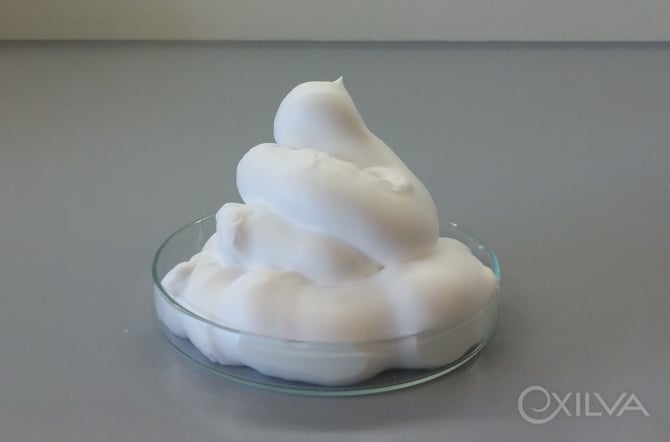
Having trouble producing stable foams?
Anni Karppinen | February 28, 2017
Making foams, in other words introducing gas in a solid or liquid, is needed in industries like construction, composites, home care and personal care. Solid foam is a clever way to produce lightweight structures and insulation materials, whereas many personal care and detergent formulations are required to form a liquid foam.
To produce solid foams, you need a blowing agent which introduces gas bubbles in the solid and a solid (often a polymer) that hardens around them. Liquid foams are mainly created by using surfactants and mixing air in. Earlier on this blog, we have explained how microfibrillated cellulose can be used for creating bubble-free gel coats. Could it also help forming intentional foam structures?
Bubbles to your bath tub
Many personal care products should form a foam when they are used, for example, bubble bath products or shampoos. The bubbles are partly needed to make it easier to apply, for example, shampoo to your hair, and partly because the foam gives an impression of an effective, luxury product. In cleaning products, a stable foam allows a longer contact time with surface, thus improving the cleaning outcome. MFC can help to make long-lasting liquid foams since it has a high yield stress, it is a good stabilizer, and it is compatible with surfactants. However, MFC does not affect the surface tension and it is not a surfactant so it should be combined with surfactants to produce nice foams.

Figure 1. Shaving foam stabilized with MFC (Exilva, Borregaard).
Insulation structures
Many insulation materials, like expanded polystyrene (EPS), are solid foams. The gas trapped inside the matrix improves the insulation properties drastically. Lately, there have been attempts to make a biodegradable, sustainable solid foams to replace the oil-based products. For instance, poly(vinyl alcohol) (PVOH) and poly(lactic acid) (PLA) can be combined with MFC to create a green foam composite. Zhao et al. compounded MFC in the PVOH matrix and then made foam by extrusion, using super critical CO2 and water as blowing agents. MFC acted as cell nucleating agent and helped to control the cell structure. In Boissard’s et al. work, the water that follows with MFC acted as foaming agent for PVOH. With MFC, they were able to produce low-density material.
Potentially, MFC could also strengthen the foam composites since the fibers are mechanically very strong. Cellucomp has successfully utilized this in their Cellufoam material which could be used to replace EPS in, for instance, helmets.
Foaming is not always desired!
I have witnessed the foaming properties of MFC few times myself – in situations that I did not want them. When introducing MFC into a formulation, high shear mixing is needed. If you happen to have also surfactants in the formulation (as you often do), you get foaming, and MFC is making that worse by stabilizing the foam. MFC fibers tend to get into the foam and after a while, you have a stable foam on the top with the MFC and the rest of the formulation is at the bottom. To avoid this, you need to either use an airless mixer or add defoamer to your formulation. Where the foaming is desired, MFC can show a sustainable approach to achieving this – whether it is liquid or solid foam.
Written by:
Anni Karppinen
